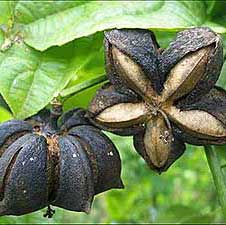
Producing Sacha Inchi oil has important advantages compared to the production of other plants with highly unsaturated oils.
Agronomic Advantages
- Sacha Inchi has a long production time and crop life. There have been plants found that have been producing for 75 years.
- Sacha Inchi production is high, at more than 4,000 kilos per hectare.
- Sacha Inchi is harvested throughout the year.
- Growing costs of Sacha Inchi are lower than those of other oil-producing plants.
- Sacha Inchi enables associated crops to be cultivated, resulting in high economic yields per hectare.
Industrial Advantages
Sacha Inchi seed has a high oil content – more than 50% – more oil can be obtained therefore, more omega 3. The oil is extracted by simple cold pressing and does not require refining.
High Concentration of Essential Fatty Acids and Omega 3
Sacha Inchi oil has a naturally higher concentration of essential fatty acids (84%), with more than 48% being Omega 3.
Nutritional Advantages
Sacha Inchi oil contains nothing that is toxic or damaging to good health, so there is no restriction on human consumption. Sacha Inchi oil was awarded the gold medal of excellent organoleptic qualities at the World Edible Oils competition in Paris in 2004; Other oils rich in Omega 3, such as linseed and perilla, contain toxins and therefore not allowed to be used for human consumption in some countries.
In addition to their high concentration of high-quality oil, Sacha Inchi seeds are exceptionally high in quality protein and are rich in essential amino acids, 96% of which is very easily digestible.
Environmental Advantages
Sacha Inchi is a forest crop and encourages reforestation of the Amazon. Being grown in the Amazon forest has a more positive impact than that of other oil plants.
Economic Advantages
The higher seed production per hectare added to the higher oil content of the seed and the ease of industrial processing gives Sacha Inchi considerable advantages over other oil plants used to produce oils and proteins for human consumption, cosmetics and neutraceutics.

Reader Interactions